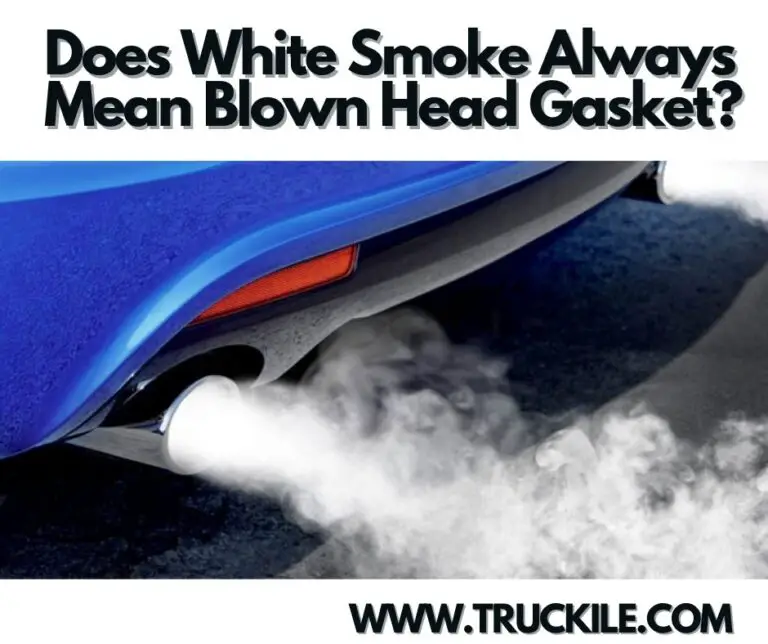Should New Catalytic Converters Smoke?
You may be wondering why your new catalytic converter is smoking? There are a few reasons for this and your mechanic can tell you if any of these apply to you.
Let’s proceed to give the reason(s).
Should New Catalytic Converters Smoke?
A brand new catalytic converter should not smoke. If it smokes in the first couple of weeks, it is probably just getting rid of the oil that was put in it during the manufacturing process.
Can Catalytic Converters Cause Smoke?
Catalytic converters, like any other car part, can fail and cause problems with your vehicle. One of the most common issues is a clogged catalytic converter. This can cause smoke, engine misfires, and poor performance.
Here are some of the main causes of a clogged catalytic converter:
– Bad spark plugs: If your spark plugs are dirty or worn out, this can cause unburnt fuel to enter the exhaust system. The catalytic converter will absorb the excess fuel which burns and causes smoke.
– Oil leaks: If you have an oil leak, then it’s possible for the oil to enter the exhaust system. This can happen if your vehicle has an oil leak from a faulty valve cover gasket or head gasket. Once again, the unburnt oil will get absorbed into the cat and burn off, causing smoke to exit the exhaust pipe.
– Intake manifold leaks: If you have an intake manifold leak that is causing unmetered air to enter your engine, this will cause a rich mixture. The rich mixture will result in extra fuel being burnt in the catalytic converter which can produce smoke.
What Should You Do After Replacing Catalytic Converter?
To start the break-in procedure, start the car after you’ve replaced the cat. Let the car idle in place without applying any gas. When the engine warms up to its operating temperature, get inside and give the car enough gas to bump the RPMs to around 2500. Hold it there for 2 minutes and then release the gas.
This will form a thin coat of ash on your catalytic converter that allows exhaust gases to pass through. This process should be repeated until you’ve put around 100 miles on your car.
After this break-in period is over, you can drive as usual. However, make sure that you’re not driving aggressively over bumps or potholes, or else you’ll knock off the thin coating of ash that has formed on your converter.
Also, take note that older cars require longer break-in periods than newer cars do. So if your vehicle is more than 10 years old, you may need to repeat the first step multiple times until it reaches 100 miles of use.
Does A Catalytic Converter Need To Break In?
A replacement catalytic converter needs a proper “break-in” period. If the converter is not warmed-up (broken-in) properly, the substrate inside could be adversely affected and eventually cause the converter to fail down the road.
What’s the best way to break in a new catalytic converter?
After a catalytic converter has been installed, it’s important to follow some break-in instructions for optimal performance. A converter that has been broken in correctly will have a longer service life and better overall performance.
Step 1: Start with a cold engine.
Step 2: Accelerate to 40 mph and maintain that speed for 10 minutes. Don’t exceed speeds of 60 mph or drive aggressively during this time.
Step 3: Decelerate slowly to 20 mph, then accelerate back to 40 mph and repeat this process two or three times.
Step 4: Once you’ve completed these steps, drive normally — no special acceleration or cruising speeds are required after this initial break-in period.
How Can I Tell If My Catalytic Converter Is Clogged?
Catalytic converters are made from a honeycomb ceramic coated with platinum and palladium, which is designed to speed up the chemical reactions that reduce toxic gases. Over time, various contaminants may clog the converter, reducing its efficiency. The good news is that it’s easy to test a converter and see if it’s clogged:
Examine the converter. Look for any signs that the converter has been damaged or compromised in some way. If the case has rusted or split open, or if there are signs of melting, it should be replaced.
Test the converter efficiency. Hook up an oxygen sensor to your exhaust system on either side of the converter, then do a short test drive while measuring oxygen levels before and after the catalytic converter. If there’s no difference, your converter is clogged and needs replacing.
Check for other possible problems. There are several other symptoms that could point to a clogged catalytic converter: poor fuel economy; misfiring engine; engine hesitation; excessive exhaust emissions; back pressure in the exhaust system; knocking noises from under the vehicle.
Can A Catalytic Converter Unclog Itself?
No, a catalytic converter cannot unclog itself. It can, however, place a load on your engine that will cause serious damage while it remains clogged.
A catalytic converter works by burning up the excess hydrocarbons and carbon monoxide in your exhaust. It also contains a chemical catalyst (platinum or rhodium) that allows this reaction to occur at lower temperatures than would otherwise be necessary.
This is important because the temperature of the exhaust exiting your engine is only about 600 degrees Fahrenheit when it reaches the catalytic converter.
It doesn’t need much maintenance, but it does need to be replaced at some point in the life of your car. Replacing a catalytic converter is usually not very expensive because it is just an empty metal chamber with a screen inside.
However, if you have one of the more expensive heavy-duty versions, you may be looking at as much as $1,000 for replacement costs.
What Can Cause A Catalytic Converter To Overheat?
A properly operating catalytic converter should not have any significant impact on engine performance or fuel economy.
An overheated catalytic converter is often the result of excess hydrocarbon (HC) in the exhaust stream. Unburned fuel is entering the catalytic converter and then burning, creating intense heat.
The most likely cause for a clogged or damaged catalytic converter substrate is excess unburned fuel in the exhaust.
Sometimes, it may be necessary to perform a routine maintenance procedure known as a “catalytic converter burn-off.”
This involves turning off all electrical loads on the vehicle (such as headlights, air conditioning, and radio), driving at highway speeds with low throttle openings, and allowing excess HC stored in the catalytic converter to combust in order to burn off carbon deposits that may have built up on the substrate.
GFGHJGJGHKJGHK
The average light-off temperature at which a catalytic converter begins to function ranges from 400 to 600 degrees F. The normal operating temperature can range up to 1,200 to 1,600 degrees F. But as the amount of pollutants in the exhaust go up, so does the converter’s operating temperature.
It, the catalytic converter, must reach its light-off temperature before it will function. The engine must be running at sufficient RPMs for enough exhaust gas to flow through the converter to reach and maintain that light-off temperature.
The catalytic converter is designed to remove harmful hydrocarbons (HC), carbon monoxide (CO), and oxides of nitrogen (NOx) from the exhaust stream. It does this by converting them into water vapor and carbon dioxide.
The converter works most efficiently when it reaches its normal operating temperature of 1,200 degrees F., but not all vehicles have converters that operate at that high of a temperature.
Should New Catalytic Converters Smoke – Conclusion
As a recap of the response we gave to the question, Should New Catalytic Converters Smoke?
A brand new catalytic converter should not smoke. If it smokes in the first couple of weeks, it is probably just getting rid of the oil that was put in it during the manufacturing process.
Thanks for reading.

Joe lives and breathes cars and trucks. After many years working in the Auto industry, he decided that it is only right to share his knowledge with the public. As a qualified expert in trucks and cars, he started working for Truckile.com and is the main editor and publisher.



